
Cappuccino
Classic Italian coffee drink prepared with espresso, hot milk, and steamed milk foam.
Nutrition Facts
* The % Daily Value (DV) tells you how much a nutrient in a serving of food contributes to a daily diet. 2,000 calories a day is used for general nutrition advice.
Art in Coffee
The cappuccino evolved from the Viennese 'Kapuziner' coffee in the 18th century, which mixed coffee with cream and sugar. It wasn't until the early 20th century in Italy, with the development of espresso machines, that the cappuccino as we know it began to take shape, gradually standardizing in its modern form after World War II.
The cappuccino is deeply ingrained in Italian coffee culture and has become a globally recognized and enjoyed beverage. It is typically consumed in the morning, often as part of a breakfast ritual.
Morning Drink
In Italy, cappuccinos are traditionally enjoyed only in the morning, usually before 11 AM. Ordering one after lunch is considered unusual.
Social Ritual
Cappuccinos are often consumed in coffee bars ('bars') as a social activity, accompanied by pastries or a light breakfast.
Symbol of Italian Coffee Culture
The cappuccino is an iconic representation of Italian coffee craftsmanship and has been exported worldwide, becoming a staple in coffee shops globally.
Cappuccino offers a balanced blend of rich, intense coffee and creamy, sweet milk flavors.
The strong, roasted flavor of espresso is softened by the addition of warm milk and further complemented by the light, airy sweetness of steamed milk foam. The coffee provides a slightly bitter and robust base, while the milk adds smoothness and a subtle sweetness. The foam contributes a textural element, enhancing the overall sensory experience.
Espresso Quality
Use freshly roasted, high-quality coffee beans and a proper espresso machine to extract a rich and flavorful espresso shot. The quality of the espresso significantly impacts the overall taste.
Milk Frothing Technique
Properly steamed milk is crucial. Aim for microfoam—tiny, uniform bubbles that create a smooth, velvety texture. Overheated milk or large bubbles will result in a less desirable cappuccino.
Ratio Matters
The classic cappuccino ratio is 1/3 espresso, 1/3 steamed milk, and 1/3 milk foam. Adjusting the ratio can alter the flavor and texture of the drink.
Temperature Control
Serve the cappuccino immediately after preparation while the espresso and milk are hot. This preserves the flavor and texture of the drink.
Explore additional Coffee dishes and restaurants
Explore CoffeeDiscover top dining spots and culinary experiences in Aracaju.
Explore AracajuLearn more about the food culture, restaurant scene, and culinary heritage of Brazil.
Explore Brazil